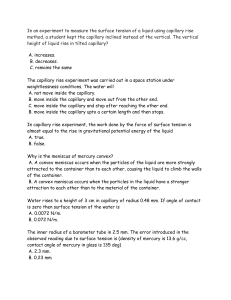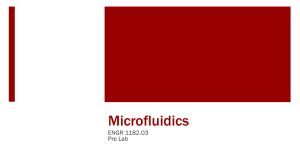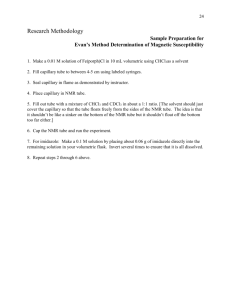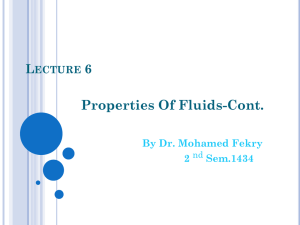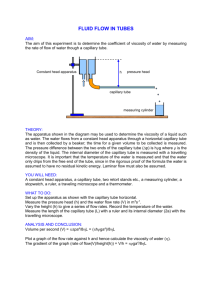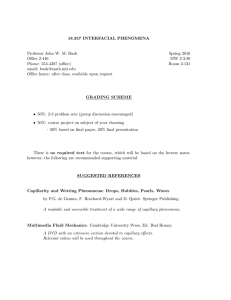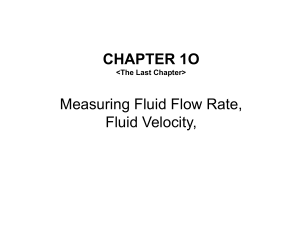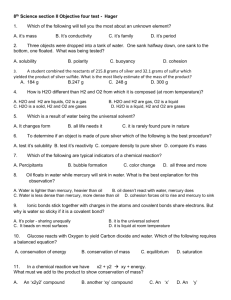FM UNIT 1
advertisement
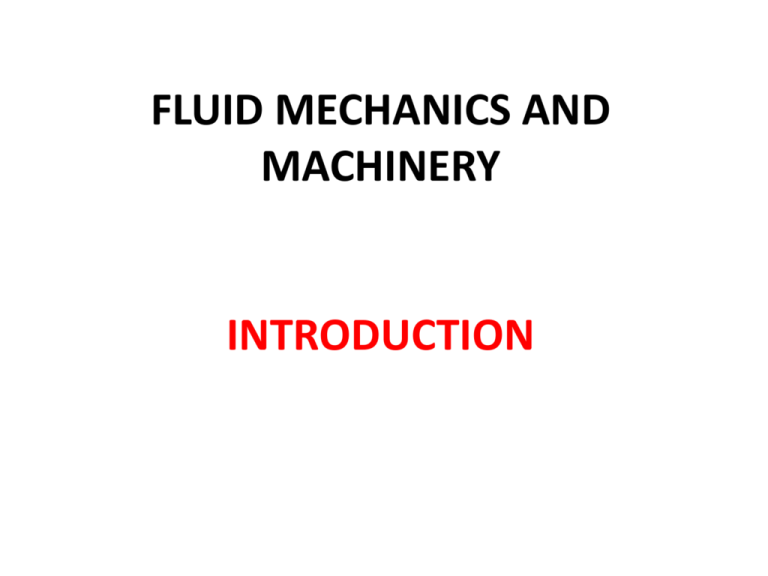
FLUID MECHANICS AND MACHINERY INTRODUCTION Density Density is given by: m = V The symbol for density is “rho.” Density is simply mass per unit volume. Water, for example, has a density of about 1 gram per milliliter. (It varies slightly with temperature and pressure.) The S.I. unit for density is the kg /m 3. For water: 1000 kg 1 g 1 mL (100 cm) 3 1 kg = = mL · · · 3 3 m3 1 cm m 1000 g Pressure is given by: Pressure F P= A Pressure is simply force per unit area. Pressure is often measured in pounds per square inch (psi), atmospheres (atm), or torr (which is a millimeter of mercury). The S.I. unit for pressure is the pascal, which is a Newton per square meter: 1 Pa = 1 N /m 2. Atmospheric pressure is at sea level is normally: 1 atm = 1.01 ·10 5 Pa = 760 torr = 14.7 psi. At the deepest ocean trench the pressure is about 110 million pascals. Pressure / Density Questions 1. Why do snowshoes keep you from sinking into the snow? The snowshoes greatly increase the area over which your weight is distributed, thereby decreasing the pressure on the snow. 2. Why do swimmers float better in the ocean than in a lake? Because of the salt dissolved in it, seawater is about 2.5% denser, making people (and fish) more buoyant in it. 3. Why don’t they make longer snorkels so that people could dive deeper without scuba gear? The pressure difference just 6 m below water is great enough so that the air in the diver’s lungs will be forced through the tube, collapsing his lungs. A shorter snorkel might not be fatal, but the pressure difference could prevent him from expanding his lungs (inhaling). 4. Which is denser, Earth or the sun? On average, Earth is denser, but the core of the sun is much denser than anything on Earth. Specific Weight Specific weight of a fluid, • Definition: weight of the fluid per unit volume • Arising from the existence of a gravitational force • The relationship and g can be found using the following: Since therefore = m/ = g Units: N/m3 Typical values: Water = 9814 N/m3; Air = 12.07 N/m3 5 Copyright © ODL Jan 2005 Open University Malaysia Specific Gravity The specific gravity (or relative density) can be defined in two ways: Definition 1: A ratio of the density of a liquid to the density of water at standard temperature and pressure (STP) (20C, 1 atm), or Definition 2: A ratio of the specific weight of a liquid to the specific weight of water at standard temperature and pressure (STP) (20C, 1 atm), SG liquid water @ STP liquid water @ STP Unit: dimensionless. 6 Capillary Action How do trees pump water hundreds of feet from the ground to their highest leaves? Why do paper towels soak up spills? Why does liquid wax rise to the tip of a candle wick to be burned? Why must liquids on the space shuttle be kept covered to prevent them from crawling right out of their containers?! These are all examples of capillary action--the movement of a liquid up through a thin tube. It is due to adhesion and cohesion. Capillary action is a result of adhesion and cohesion. A liquid that adheres to the material that makes up a tube will be drawn inside. Cohesive forces between the molecules of the liquid will “connect” the molecules that aren’t in direct contact with the inside of the tube. In this way liquids can crawl up a tube. In a pseudo-weightless environment like in the space shuttle, the “weightless” fluid could crawl right out of its container. Capillary Effect • Capillary effect is the rise or fall of a liquid in a smalldiameter tube. • The curved free surface in the tube is call the meniscus. • Water meniscus curves up because water is a wetting fluid. • Mercury meniscus curves down because mercury is a nonwetting fluid. • Force balance can describe magnitude of capillary rise. Surface Tension Ever wonder why water beads up on a car, or how some insects can walk on water, or how bubbles hold themselves together? The answer is surface tension: Because of cohesion between its molecules, a substance tends to contract to the smallest area possible. Water on a waxed surface, for example, forms round beads because in this shape, more weak bounds can be formed between molecules than if they were arranged in one flat layer. The drops of water are flattened, however, due to their weight. Cohesive forces are greater in mercury than in water, so it forms a more spherical shape. Cohesive forces are weaker in alcohol than in water, so it forms a more flattened shape. mercury water alcohol Surface Tension • Liquid droplets behave like small spherical balloons filled with liquid, and the surface of the liquid acts like a stretched elastic membrane under tension. • The pulling force that causes this is – due to the attractive forces between molecules – called surface tension ss. • Attractive force on surface molecule is not symmetric. • Repulsive forces from interior molecules causes the liquid to minimize its surface area and attain a spherical shape. Viscosity • Viscosity is a property that represents the internal resistance of a fluid to motion. • The force a flowing fluid exerts on a body in the flow direction is called the drag force, and the magnitude of this force depends, in part, on viscosity.

